To start a backyard food forest, you’ll want to assess your space and resources first. Map out the area, noting sunlight and existing plants. Choose a mix of fruit trees, shrubs, and herbs that fit your climate and soil. Prepare the soil with organic amendments and mulch to retain moisture. Plant in layers for diversity, and maintain with regular watering and weeding. As you plan, consider how to best enjoy your harvest—there’s much more to explore!
Key Takeaways
- Assess your yard’s sunlight, soil quality, and drainage to determine the best layout for your food forest.
- Design your food forest with diverse plant layers, including trees, shrubs, and ground cover for optimal space utilization.
- Choose a mix of native, fruit-bearing, and nitrogen-fixing plants to enhance biodiversity and soil fertility.
- Prepare the soil by testing pH, amending with compost, and mulching to retain moisture and suppress weeds.
- Harvest produce at the right time and explore preservation methods to enjoy your yield throughout the year.
Understanding the Concept of a Food Forest
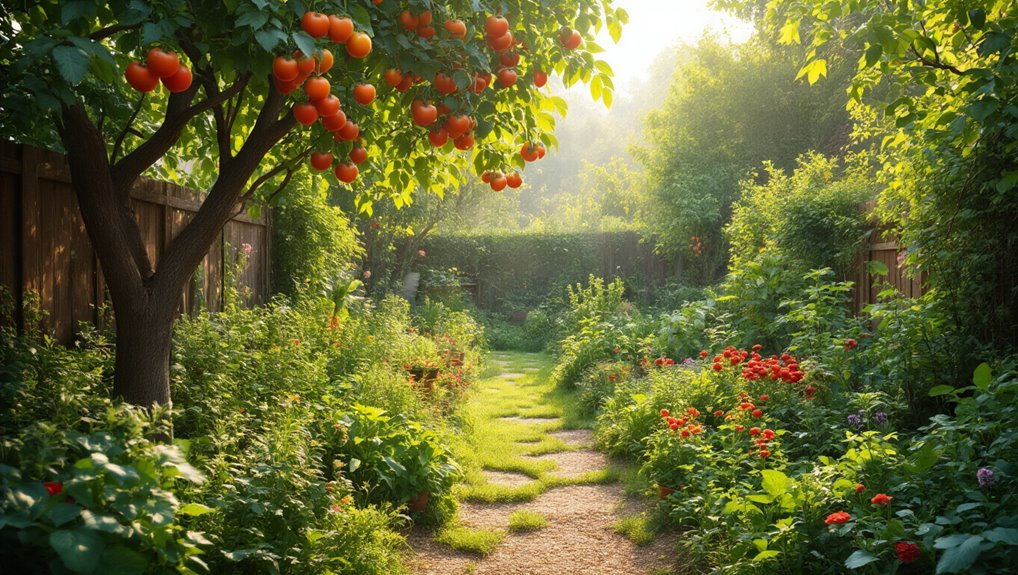
A food forest isn’t just a garden; it’s a diverse ecosystem designed to mimic natural woodland environments while providing food.
Imagine walking through a lush area filled with fruit trees, berry bushes, and edible perennials, all thriving together. You’ll create layers: tall trees, smaller shrubs, ground cover, and root crops, making the most of your space. Many gardeners recommend using organic mulching materials like straw to further boost plant health and soil quality.
This design fosters biodiversity, attracting pollinators and beneficial insects, which help your plants flourish. You’ll also minimize the need for chemical fertilizers and pesticides, as the ecosystem balances itself naturally.
One essential element for a thriving food forest is using mulch, which helps retain soil moisture, suppress weeds, and improve soil health.
Assessing Your Space and Resources
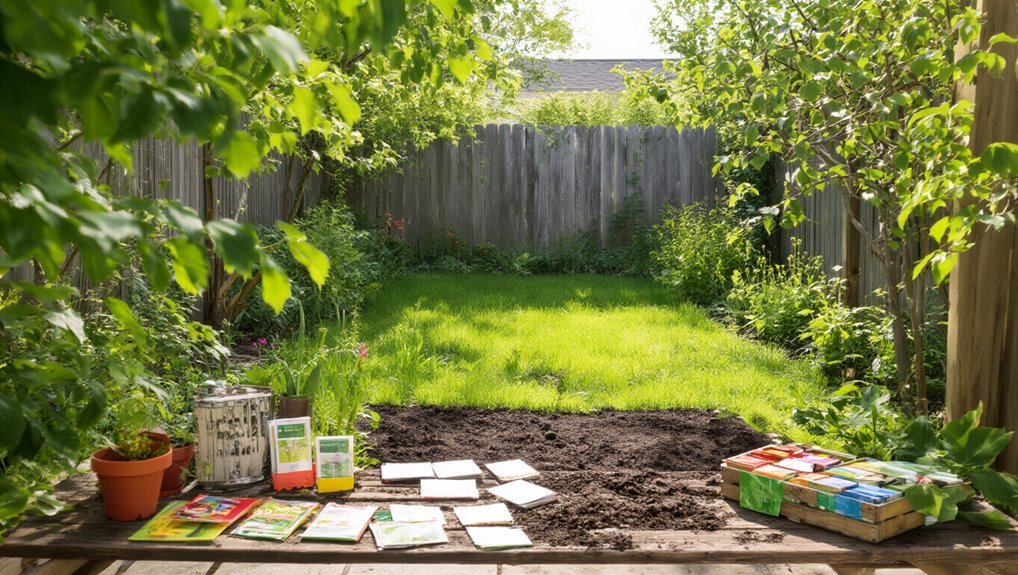
Before you start planting, take a good look at your space and the resources you have available. Assess the sunlight exposure, soil quality, and drainage in your yard. Note any existing trees, shrubs, or structures that might affect your layout.
Consider your climate and how it influences your growing season. Having the right watering cans on hand ensures your new plantings receive consistent moisture as they establish.
Next, evaluate the tools and materials you already own. Do you have shovels, compost, or mulch? If not, plan for these essentials.
Also, think about your time commitment; how often can you maintain your food forest? Understanding your limitations and resources will help you design a productive space that thrives.
One essential addition to your resources is a compost bin, which can turn kitchen and garden waste into nutrient-rich soil for your food forest.
Choosing the Right Plants for Your Climate
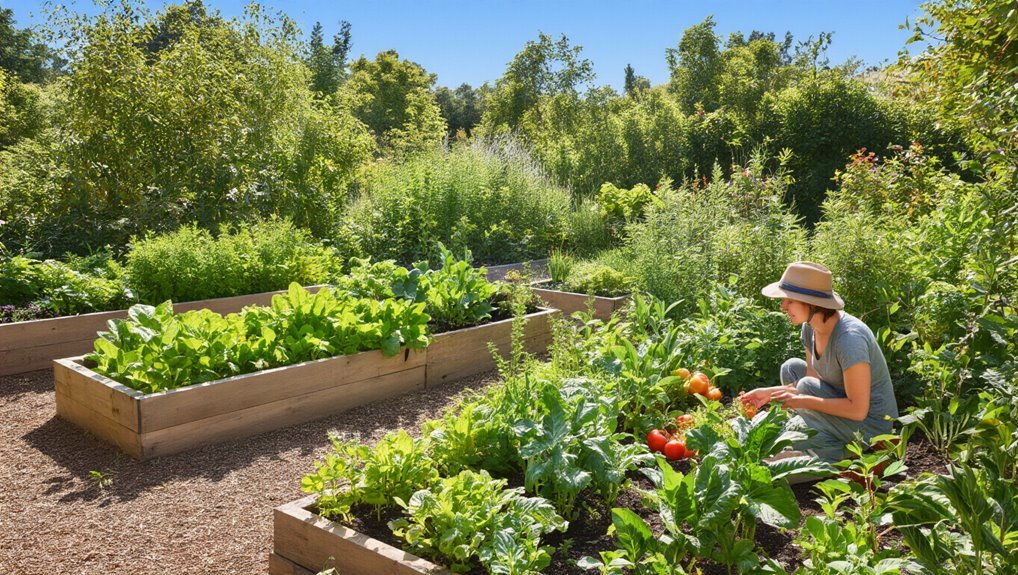
While selecting plants for your food forest, it’s essential to consider your local climate, as it directly impacts which species will thrive.
Start by determining your USDA hardiness zone, which helps you identify plants that can withstand your area’s temperature extremes.
Research native plants, as they’re well-adapted to local conditions and often require less maintenance. You might also want to incorporate edible flower seeds into your landscape design, as these can add both beauty and unique flavors to your harvests.
Consider the amount of sunlight your site receives—some plants thrive in full sun, while others prefer partial shade.
Look into soil types too; certain plants have specific soil requirements.
Lastly, think about seasonal variations and select a mix of perennials and annuals to ensure year-round harvests.
To give your plants the best possible start, consider using seed starting kits to help ensure strong germination and healthy young plants.
Designing Your Food Forest Layout
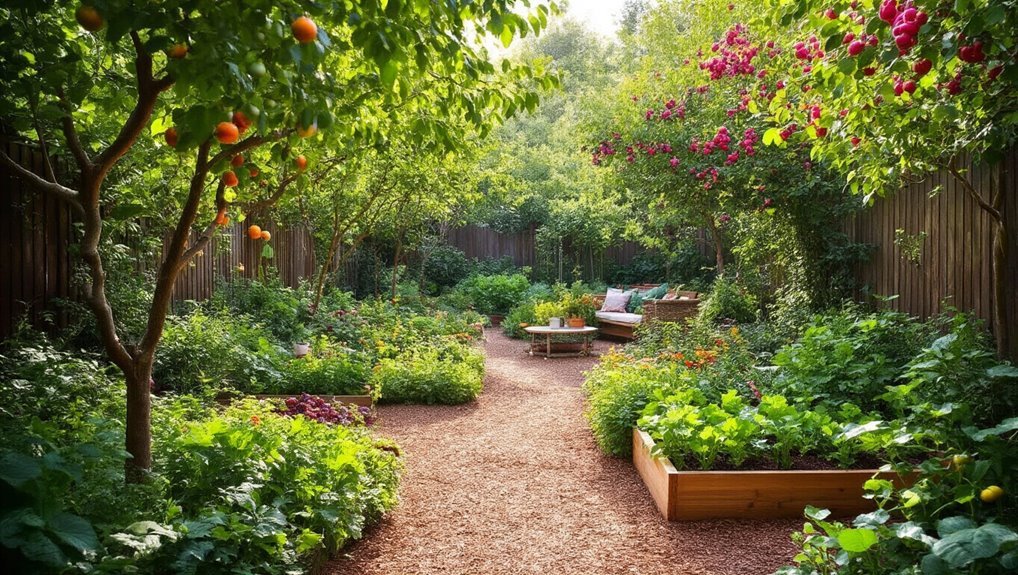
Creating an effective layout for your food forest involves several key considerations.
Start by mapping your space, noting sun exposure, existing trees, and drainage patterns. This helps you position taller trees on the north side, allowing sunlight to reach shorter plants. Incorporating raised garden beds can help optimize growing conditions in areas with poor soil or drainage.
Next, plan for layers: canopy trees, understory trees, shrubs, herbs, and ground cover. This vertical diversity maximizes space and promotes a healthy ecosystem.
Consider pathways for easy access and maintenance, ensuring they’re wide enough for wheelbarrows or tools.
Group plants with similar water and sunlight needs together to simplify care.
Lastly, incorporate wildlife-friendly elements like birdhouses or pollinator gardens, which can enhance biodiversity and support your food forest’s overall health.
For gardeners with limited space or challenging soil, grow bags offer a flexible and effective way to cultivate plants as part of your food forest design.
Preparing the Soil for Planting
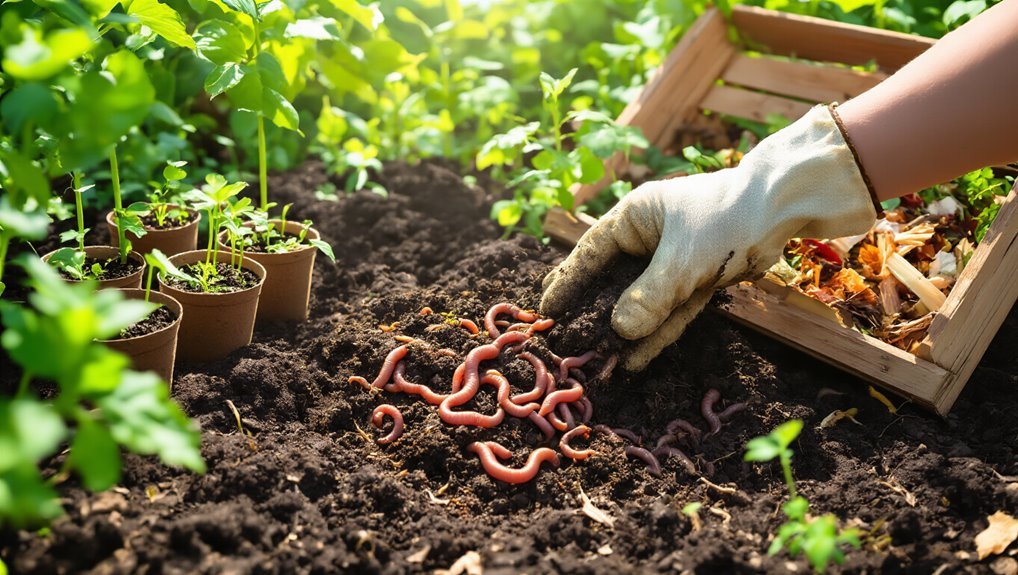
As you prepare the soil for planting, it’s crucial to assess its current condition and make any necessary amendments.
Start by testing the pH and nutrient levels, which can help you understand what your soil needs. If it’s too acidic or alkaline, you can adjust it with lime or sulfur.
Next, remove any weeds, rocks, or debris that could compete with your plants. Incorporate organic matter, like compost or aged manure, to improve soil structure and fertility. This will enhance drainage and retain moisture.
Lastly, till the soil to mix in your amendments evenly. By creating a healthy foundation, you’ll give your plants the best chance to thrive in your new backyard food forest.
Planting Techniques and Timing
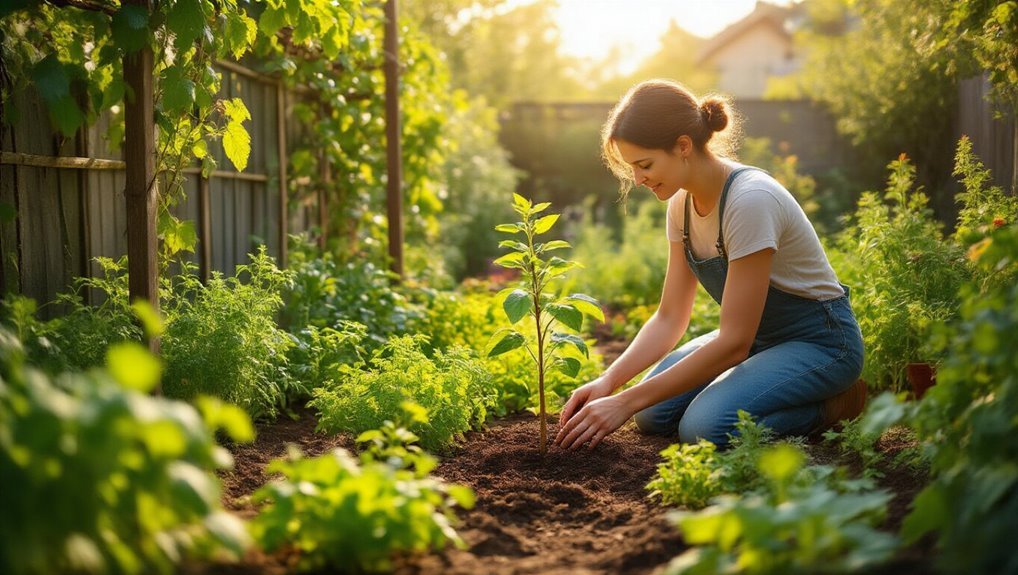
When you’re ready to plant, timing and technique are crucial to ensuring your food forest flourishes. First, choose the right season based on your climate; spring and fall are ideal for most plants. Check local frost dates to avoid damage.
Next, consider layering your plants—tall trees, medium shrubs, and low ground cover create a diverse habitat. Use companion planting to enhance growth; for instance, plant nitrogen-fixing legumes alongside heavy feeders like corn.
Dig holes wide enough to accommodate root systems, and avoid crowding to prevent competition for nutrients. Water immediately after planting and mulch to retain moisture.
Keep an eye on your plants as they establish, adjusting care as needed to promote robust growth. Happy planting!
Maintaining Your Food Forest
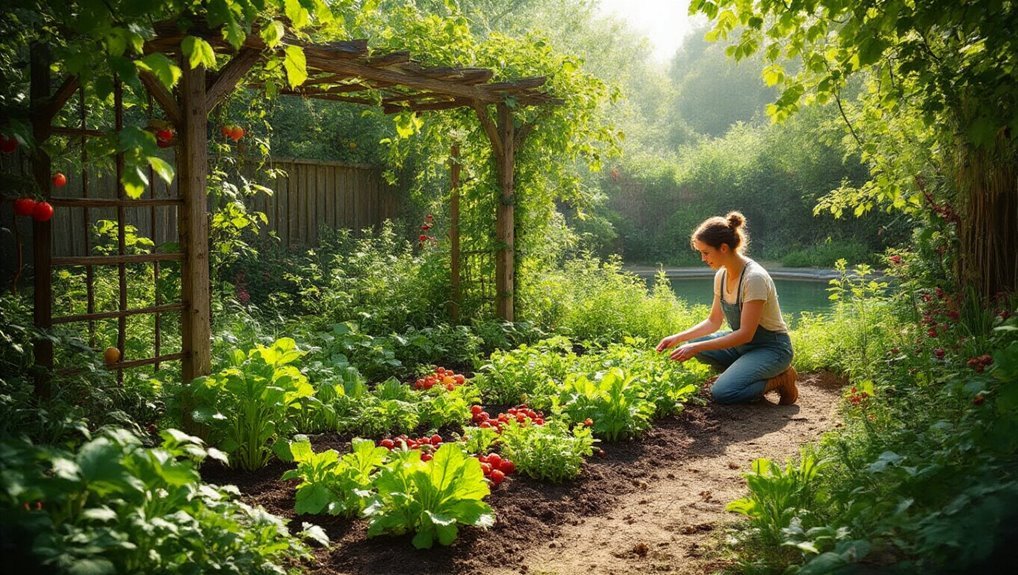
To keep your food forest thriving, regular maintenance is essential. Start by checking for weeds, as they compete for nutrients and water. Pull them out before they spread.
Next, monitor your plants for pests and diseases; early detection can save your harvest. Prune trees and shrubs to encourage healthy growth and improve air circulation.
Water your plants consistently, especially during dry spells, but avoid overwatering. Mulching helps retain moisture and suppress weeds.
Fertilize your soil with compost or organic fertilizers to ensure your plants get the nutrients they need. Lastly, keep an eye on seasonal changes; adjust your care routine accordingly.
Harvesting and Enjoying Your Bounty
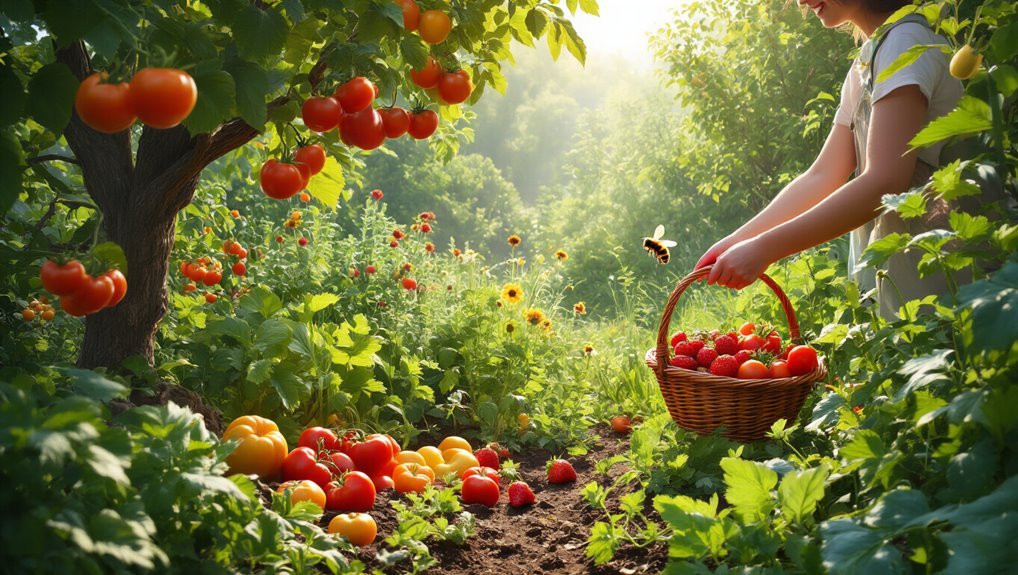
Harvesting your bounty is one of the most rewarding aspects of maintaining a food forest, especially when you see the fruits of your labor come to life.
As you gather fresh produce, remember to pick items at their peak ripeness for the best flavor and nutrition. Don’t hesitate to try different methods of harvesting, whether it’s snipping herbs or picking fruits by hand.
Once you’ve collected your bounty, think about how you’d like to enjoy it. Fresh salads, homemade jams, or even simple snacks can highlight the flavors of your harvest.
Share your bounty with friends and family to spread the joy and inspire others to start their own food forests. Your hard work truly pays off in delicious ways!
Frequently Asked Questions
Can I Start a Food Forest in a Small Urban Backyard?
Absolutely, you can start a food forest in a small urban backyard! With careful planning and space management, you’ll maximize your area for growing a variety of edible plants, enhancing both beauty and sustainability.
How Long Does It Take for a Food Forest to Mature?
It usually takes about three to five years for a food forest to mature. During this time, you’ll see gradual growth and increased yields, so be patient and enjoy the process of nurturing your plants.
Are Food Forests Resistant to Pests and Diseases?
Imagine a medieval castle surrounded by lush gardens. Food forests can be more resistant to pests and diseases due to diverse plantings, natural ecosystems, and companion planting. You’ll find healthier plants thrive in this environment.
Can I Integrate Animals Into My Food Forest?
Yes, you can integrate animals into your food forest! Chickens, ducks, and bees enhance biodiversity, control pests, and pollinate plants. Just ensure they have enough space and don’t damage your crops in the process.
What Are the Costs Associated With Starting a Food Forest?
Starting a food forest can be a bit of a mixed bag, cost-wise. You’ll need to budget for plants, soil amendments, tools, and maybe even water supplies. It’s worth every penny for fresh produce!
Conclusion
Creating your backyard food forest is like planting a little piece of paradise right outside your door. With careful planning, the right plants, and a bit of patience, you’ll watch your garden flourish, bringing food and joy to your table. Embrace the journey, and let nature’s rhythm guide you as you harvest the fruits of your labor. Remember, every seed you sow is a step toward a more sustainable and delicious future. Enjoy the bounty!


